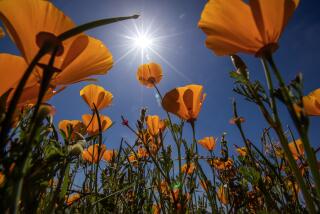FEBRUARY GARDENING SPECIFICS . . .
Many people believe that summer-blooming bulbs are limited to dahlias and gladiolus. But there are numerous varieties to be planted now that will bloom as early as May and as late as October. Bulbs and tubers such as tigridia, liatris, crinum, begonias, lilies, Japanese irises and eucomis are also available in nurseries this time of year.
Tigridia, also called Mexican shell flower, provide vibrant color and resemble miniature orchids. Liatris, with its showy blue or white plumes, is often used in florist’s arrangements.
Lilies are often overlooked at spring planting time, even though they are very popular as cut flowers. In flower shops, lilies often sell for as much as $12 a stem, but a single bulb may be purchased for about $3.50 and will produce many blooms for years to come. Casablanca lilies have large, fragrant white blossoms on stately stems.
But if you want a more exotic look, try voodoo lilies, which produce a purplish-black foliage and a greenish blossom marked with deep purple. All lilies grow best in a rich soil of peat moss and good planter mix.
Dahlias are often the earliest bloomers, producing their first flowers in May. If you want an abundance of large blooms, select the dinner plate variety and pick them often. The more you cut off, the more flowers you get.
Most summer-blooming bulbs need a rest period of three to four months in the fall and winter after the foliage dies back. Lilies, however, need to stay just slightly moist during the dormant period.
February and March are the best months to plant tuberous begonias. Get them to sprout roots and foliage by setting them concave side up in a standard nursery flat filled with equal parts pre-moistened leaf mold and peat moss.
Avoid crowding the tubers and don’t cover them. Instead, plant them so they are half in and half out of the soil. Place them in a protected area that receives bright, filtered sun. Keep slightly moist. Once foliage is three inches high, transfer tubers with their root masses into pots or baskets using a potting mix of half leaf mold and half potting soil. Water once a week, or when the top two inches of soil is dry. Keep foliage dry and provide good air circulation.
Source: Cristin Fusano, Color Specialist/Horticulturist, Sherman Library and Gardens
. . . AND GENERAL FEBRUARY CARE TIPS
Prepare your soil with amendments to get the most from spring and summer annuals and perennials.
Start your vegetable plantings as soon as weather permits. Extend your harvest by planting in two-week intervals.
Sharpen your tools now before the big spring outdoor season begins. Hedge and pruning shears should be sharp so they don’t bruise the bark of limbs.
Pre-emergent weed killers applied to your lawn now will, in most cases, kill crabgrass seedlings as they germinate.
To conserve water and prevent weeds, apply a two- to three-inch layer of mulch around shrubs, trees and plants.
Source: California Assn. of Nurserymen.






